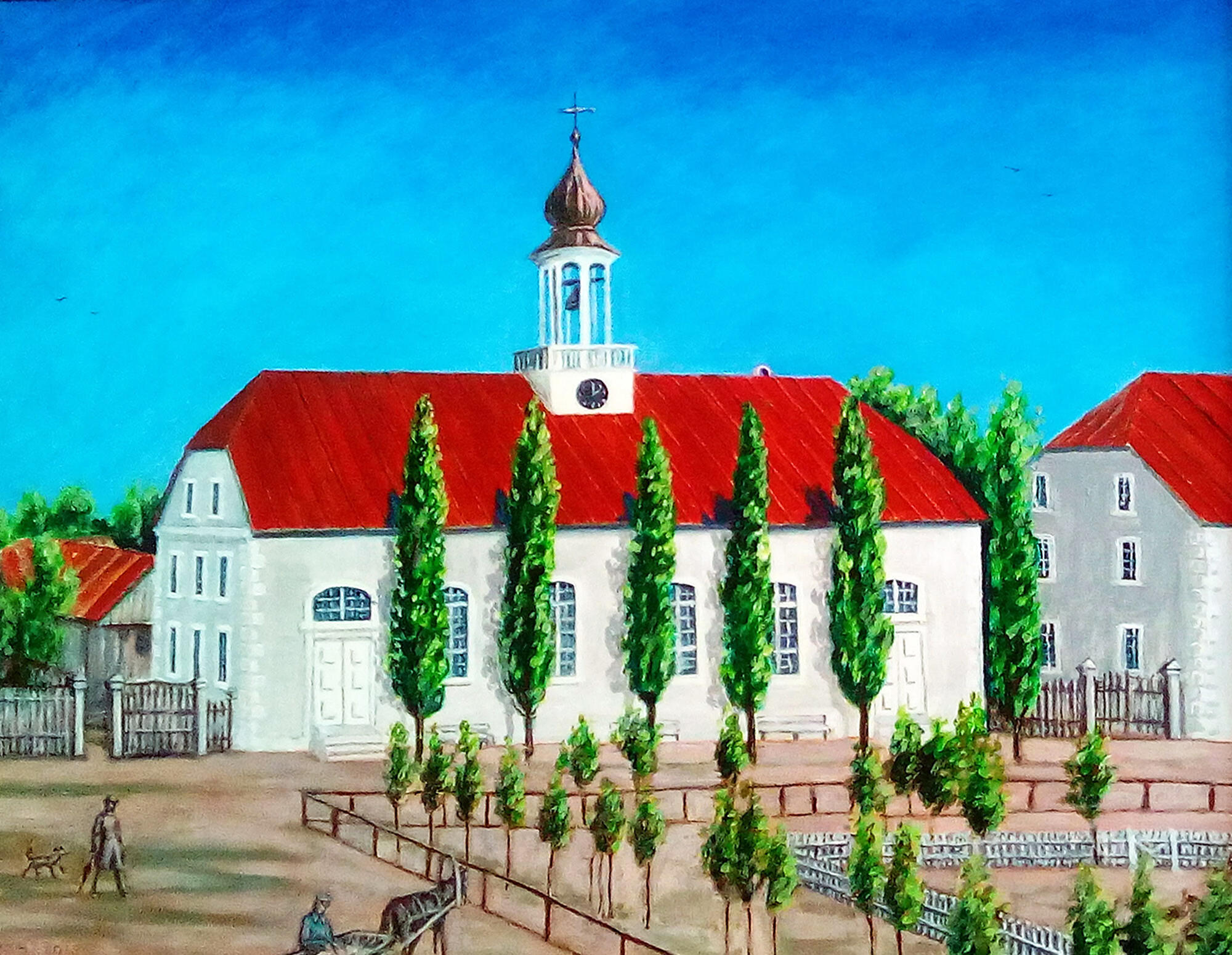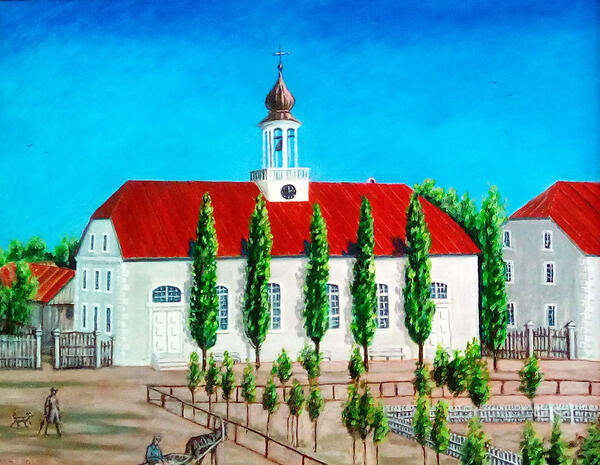The colony of the Evangelical Fraternal Community of Gernguter in Sarepta arose in 1765 during spublic economic colonization of the Lower Volga region and southern Russia. The GerngUters were representatives of Protestantism. In his painting, Valery Konkov recreated the most important building of the ‘kirkha’ - ‘church’ in German.
The construction of the stone church began in 1771 basing on the German model of one the Brotherhood Hernguther Union churches. The foundation was made of wild stone. The walls are made of local bricks. During the laying of the first stone of the future temple, the Sareptians immured a lead jar with a letter to descendants and a copper memorial tablet into the foundation. During the restoration of the church in the 20th century, these items were not found.
The Protestant church was one of the first stone buildings of the colony. It looks different from the usual Lutheran church. There were two dials and a spire with a weather vane on the tower. The clock dial overlooking the colony square was black. The dial facing the cemetery was white. Clocks at that time were usually installed on city halls, and the towers of churches were crowned with crosses, not weather vane. Such features of the Sarepta church symbolized the unity of spiritual and secular life in the settlement.
The location of the church was not chosen by chance. Sarepta had a cruciform layout that embodied the idea of a crucifixion. The ‘bottom’ of the cross was made up of trade and craft quarters. The horizontal crossbar was formed by streets with communal houses. The road to the cemetery ran along the ‘top’ of the cross - the path to the afterlife. The church occupied the point of intersection of the crossbeam and the ‘top’; on an ordinary crucifix, the head of Jesus Christ is depicted at this point. Thus, the church ‘headed’ the symbolic cross.
In 1892, Sarepta was expelled from the Fraternal Union. Two years later, the church was handled to the Evangelical Lutheran Church of Russia. Its interior and exterior was changed in accordance with Lutheran norms.
As decided by the Soviet authorities, the church was closed in 1938. Its tower and the organ were dismantled. The building housed ‘Kultarmeyets’ cinema at first, then since 1967 - a warehouse for supermarket.
When Old Sarepta Museum-Reserve appeared, the church became an integral part of the museum’s historical and architectural complex. In 1996, it was restored with donations collected by the Evangelical Lutheran community of the Berlin-Brandenburg Church. Later, the museum handled the church to the use of the Evangelical Lutheran community of Volgograd. Church services were resumed.
The construction of the stone church began in 1771 basing on the German model of one the Brotherhood Hernguther Union churches. The foundation was made of wild stone. The walls are made of local bricks. During the laying of the first stone of the future temple, the Sareptians immured a lead jar with a letter to descendants and a copper memorial tablet into the foundation. During the restoration of the church in the 20th century, these items were not found.
The Protestant church was one of the first stone buildings of the colony. It looks different from the usual Lutheran church. There were two dials and a spire with a weather vane on the tower. The clock dial overlooking the colony square was black. The dial facing the cemetery was white. Clocks at that time were usually installed on city halls, and the towers of churches were crowned with crosses, not weather vane. Such features of the Sarepta church symbolized the unity of spiritual and secular life in the settlement.
The location of the church was not chosen by chance. Sarepta had a cruciform layout that embodied the idea of a crucifixion. The ‘bottom’ of the cross was made up of trade and craft quarters. The horizontal crossbar was formed by streets with communal houses. The road to the cemetery ran along the ‘top’ of the cross - the path to the afterlife. The church occupied the point of intersection of the crossbeam and the ‘top’; on an ordinary crucifix, the head of Jesus Christ is depicted at this point. Thus, the church ‘headed’ the symbolic cross.
In 1892, Sarepta was expelled from the Fraternal Union. Two years later, the church was handled to the Evangelical Lutheran Church of Russia. Its interior and exterior was changed in accordance with Lutheran norms.
As decided by the Soviet authorities, the church was closed in 1938. Its tower and the organ were dismantled. The building housed ‘Kultarmeyets’ cinema at first, then since 1967 - a warehouse for supermarket.
When Old Sarepta Museum-Reserve appeared, the church became an integral part of the museum’s historical and architectural complex. In 1996, it was restored with donations collected by the Evangelical Lutheran community of the Berlin-Brandenburg Church. Later, the museum handled the church to the use of the Evangelical Lutheran community of Volgograd. Church services were resumed.





